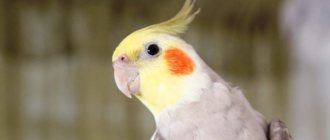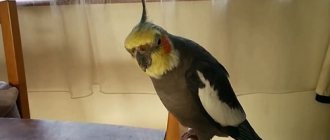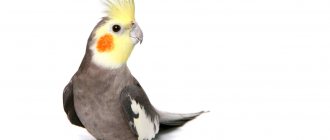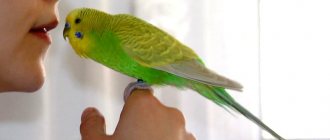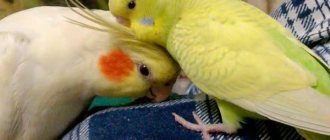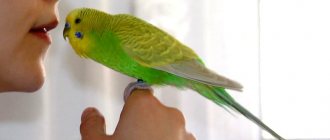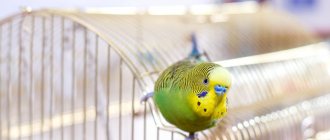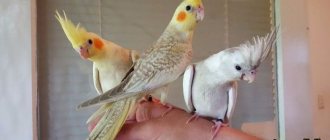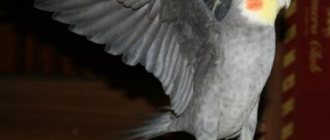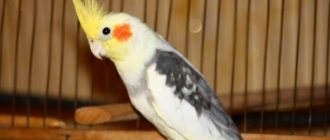The Corella parrot is a charming, proud bird from which you would not expect aggressive behavior. That is why the pet’s hostile hissing comes as a surprise to the owner. You can also understand why the cockatiel hisses when he first meets him: he is simply afraid. But how to explain bird attacks, seemingly out of the blue? Let's figure out why the bird has attacks of anger, and also think about how to wean it from hissing and biting.
The character and habits of the cockatiel
Cockatiels in a new home choose one owner for themselves. And only he will be the main part of their life. At an early age, parrots are particularly naive and gullible. They are easy to learn and train, and get along well with other birds.
Interesting! Birds prefer a female voice timbre. It is women who most often become their favorites.
Some compare the behavior of these parrots to small children. They are very curious and active. If the bird is kept in a cage, it will spend most of its time watching its owners. And with free access, he will be interested in everything. If the owner is reading a book, the cockatiel will fly up and look into it, even “taste” the pages.
In such situations, harmfulness may manifest itself. If the book is not to your liking, parrot droppings will appear on it. In this way, different species show their dissatisfaction. You can correct the situation if you remove the object you don’t like or try to correct the behavior of the bird.
In addition to flying around the room, these parrots love to sit on furniture or quickly run across the floor. Toys bring no less joy to birds.
But despite the variety of entertainment, they need regular human communication. Without it, pets experience severe stress and become wild. Aggression combined with depression often leads to the death of birds.
Parrot control
The beak, claws and wing feathers have grown
Trimming the wing feathers can help you tame your bird and also keep it from flying out of a window or into a wall. As a bird's claws and wing feathers grow, it may become more aggressive.
Direct look into the eyes
Some parrots will not bite you as long as you look them in the eye. But as soon as you look away, they may bite you. This is because some birds get wound up quickly and only need a split second to release their emotions. You should also keep in mind that an Amazon, under the influence of hormones, may consider your direct gaze into the eyes as a challenge and a threat to him personally, and respond to this. He may attack you. After all, the parrot believes that you are going to violate the boundaries of its territory or encroach on its partner.
Bare legs
Some birds are quite observant. Therefore, they can easily notice when you are most vulnerable to their bites. I have seen birds that behaved perfectly until the owners took off their shoes. The foot chase will continue until you put your boots back on or are out of the pet's reach.
More than one bird in hand
Amazons may become jealous or start fighting for their territory if you hold two birds in your hands at once. You will not be able to control both birds at the same time, thereby giving one the opportunity to bite the other or you. Two parrots mean twice the chance of being bitten.
The pleasure of biting
When I first encountered my Amazon, I was warned that he was a “difficult bird.” And this, indeed, was not an exaggeration. For the first 18 months he bit me every day. Before that, he bit through the nostril of the previous owner and hung on it like an earring. He completely bit through my lip and attacked me in the eye. He also gave my arms scars from my wrists to my elbows. He was ready to scalp me. The parrot was very talented and creative in biting me. He took great pleasure in confronting the man.
When a stranger entered the room, the parrot would become all disheveled, bow its head low and sit close to the bars of the cage. At the same time, he said in the sweetest voice: “Come here. Come here, good boy." I always warned people not to touch it. But his modest appearance and soft voice did their job: people forgot about it. Stupid in their naivety, they reached into the cage with their fingers to scratch his head. Instantly he grabbed the finger with his foot and pressed it so tightly to the bars of the cage that it was no longer possible to pull it out. And then he bit and bit and bit him. The parrot really liked this game, but few others found it funny. Few birds have such talents. Be careful with smart birds: smart parrots are often the ones who bite.
These aren't the only things that can cause or encourage biting. Each bird is individual, and the list goes on and on. If a bird bites you, think about why it did it. If you understand the reason, it will help you avoid being bitten in the future.
Thus, the article has come to an end. I hope you were able to gain useful information for yourself, understand why parrots sometimes bite and how to wean them from it. Also, please share in the comments, have you encountered problems with bites? How did you deal with them? I am sure that our readers will find your personal experience interesting and useful.
Some disadvantages
Due to its character and habits, this bird is not suitable for everyone. Therefore, before purchasing it, you must carefully study all the features of the breed.
Among the disadvantages of cockatiels, it is worth knowing about several:
- They create a mess. They scatter the remains of their food all the time. And it doesn’t matter at all whether they eat in a cage or in a room, the food will still be far from the feeder.
- They leave behind a lot of garbage. This applies to droppings in any part of the apartment and feather residues after cleaning.
- Produce a lot of dust. It is recommended to carry out wet cleaning at least once every 2 days. Otherwise, it quickly accumulates. And during bird walks it will rise into the air.
- The desire to chew on everything. Even if a bird has a large number of its own toys, it may be interested in documents, photographs, indoor plants, furniture and other interior items.
Important! Despite its disadvantages, the advantages of this breed significantly exceed them.
The main reasons for biting fingers
The beak is the main tool for expressing emotional behavior. When a bird has a playful behavior, it rubs its beak on the perch and on various objects. You can often see a bird energetically knocking its beak against a mirror or other objects. But if something doesn’t suit the bird, then the bird begins to bite and gnaw the perch, toys, and the owner’s fingers. At the same time, you can notice nervous behavior and flapping of wings, chirping and screaming. The main reasons for strange behavior are the following factors:
Sources
- https://parrotsworld.ru/raznoe/pochemu-korella-shipit-i-kusaetsya
- https://parrotsworld.ru/uhod-i-soderjanie/kak-otuchit-popugaya-kusatsya
- https://asebo.ru/morskaya-svinka/pochemu-nerazluchniki-derutsya.html
- https://propochemu.ru/zhivotnye/agressiya-u-popugaev-kak-otuchit-kusatsya
- https://asebo.ru/popugaj/pochemu-kusaetsya.html
Playing sounds
The calls of parrots differ in volume, tone, frequency and other characteristics. They determine the bird's mood and even the reasons for such behavior.
Original scream
This breed of parrot is distinguished by its noisiness. Therefore, there can be many reasons why a cockatiel yells. Birds often call in the mornings and evenings, during dawn and dusk. Many of them shout to warn their owners about danger or share their desires with them.
Some cockatiels may scream because they are missing their brethren. Such sounds are usually monotonous with notes of sadness. But in case of prolonged screaming, you need to pay attention to the pet and try to understand the reason:
- bad feeling;
- loneliness;
- stress;
- longing for the owner;
- boredom;
- the arrival of a new family member;
- irritation.
A short cry is a natural behavior of birds. But screaming for more than two hours should alert the owners. Any changes that are not typical of the cockatiel’s usual behavior are a reason for close attention and action.
A peculiar creak
If a parrot makes a peculiar creaking sound with its beak, this is normal. In this way he communicates his pleasure. These sounds are often observed after meals or before bed.
Interesting! The parrot calms itself when it creaks its beak.
Beak Gnashing
This sound is characteristic of cleaning the beak or grinding it down. The branches of apple, willow and other trees act only as chewing toys. They are not suitable for grinding. A piece of chalk or sepia can help your pet in this matter.
How to gain the trust of a feathered pet
If there is an unfriendly or not particularly smart cockatiel in the house, you will have to be patient. It is unacceptable to react with anger to aggression from a bird. In order to wean your parrot from biting, hissing and irritation, you need to take a dominant position. There are three educational techniques that can be used in combination: teaching the word “no,” introducing treats, and calm conversation.
We educate correctly
If it is determined that the parrot is not misbehaving due to fear or illness, it should be weaned from the habit of biting. To do this, make a plan and stick to it:
- Don't rush into taming. Let the bird get used to its new surroundings.
- Don't look the bird in the eyes when it is very close. A simple glance is perceived as superiority over the enemy and an incentive to fight.
- In response to aggression, it is absolutely necessary to say the words “no!” or “not allowed!” It is recommended that speech be accompanied by clapping.
- The bird bites - give a light blow to the beak. This technique can only anger the cockatiel; you need to be prepared for an attack.
It's a good idea to learn to understand the signals and sounds coming from your parrot. Perhaps in this case, hissing is not a sign of anger at all, but simply a kind of training of the speech apparatus.
We offer a treat
What if a parrot hisses and then starts tapping its beak? A good way to distract your parrot is to give it something to eat. Sometimes birds beg for food by biting their owner's ears, nose or hands.
Attention! Leave the food on the grill next to the bird or place it on a skewer. You should not serve food on your palms, as this may make the parrot even more frightened.
Let's show calm
The owner has to communicate a lot with the bird, otherwise it will be difficult to win his sympathy. Quiet speech calms an angry parrot, humility disarms. You can lovingly call out to your cockatiel when he hisses and prepares to attack. The wise bird will listen and turn from anger to mercy.
Some behavioral features
Parrots express their emotions not only by screaming and gnashing. Even yawning, raising your tuft or standing upside down will tell you about them.
Raising the crest
For cockatiels, this movement is similar to how humans raise their eyebrows. This happens during times of great surprise, fear, and confusion. The bird raises its crest and hisses during intense fear. And anything calls it:
- other birds or animals;
- any items;
- bright light in the window;
- loud sounds.
In addition, the pet raises its crest when upset or angry. In such cases, it is not recommended to approach the cage closely. It is better to talk carefully and calmly with the parrot and try to calm it down.
Hanging upside down
When a parrot hangs upside down and at the same time spreads its wings in different directions and fluffs its tail, this often leads to bewilderment of owners. In this position, he can actively flap his wings. In this unusual way, the bird communicates to others its desire to swim and splash in the water.
If the female sits on the eggs and also flaps her wings, in this case she is protecting her home. Such warnings indicate a possible attack if danger arises or comes close to the cage.
Yawn
Cockatiels yawn for several reasons:
- lack of oxygen;
- removing plugs from the ear canal;
- clearing the throat of dust;
- allergic reaction.
Important! A parrot's warm paws indicate its health.
But if yawning is accompanied by head shaking, you need to watch your pet. Such symptoms are characteristic of respiratory diseases, problems with the respiratory tract, and the development of infections.
If there are children in the house
Kids rejoice at the appearance of a colorful pet in the house, but there are a number of rules that parents should teach their children. It is important to properly arrange a home where there are birds and a small child.
To avoid any troubles, children are explained what they should absolutely not do:
- Screaming near the cage. Tell your child why the parrot is afraid of sharp sounds.
- Play with the bird like a toy: flapping, pulling out feathers, strangling.
- Open the cage without adult permission. Explain that the bird flies well and can slip out of the open window.
- You can't have a cockatiel and your small child living in the same room.
Also, parents should show by their own example how to calm excited cockatiels and how to care for them. You can train the bird together and show your child in a playful way how to wean the bird from being afraid of people.
